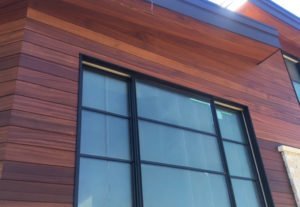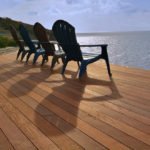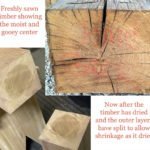 You just bought some decking or flooring (or really any lumber) and one of the first things you hear is that it needs time to acclimate to its new surroundings before installing deck boards. The maddening thing is you will rarely get the same answer twice when it comes to how long that particular lumber should sit around getting in touch with its feelings. If pressed for an answer to “how long should my decking acclimate?” I can answer with a solid “it depends”. Trying to apply a universal answer to a problem with so many variables is what gets people in trouble. You have to look closer and apply our understanding of wood science that we have been building by reading this blog.
You just bought some decking or flooring (or really any lumber) and one of the first things you hear is that it needs time to acclimate to its new surroundings before installing deck boards. The maddening thing is you will rarely get the same answer twice when it comes to how long that particular lumber should sit around getting in touch with its feelings. If pressed for an answer to “how long should my decking acclimate?” I can answer with a solid “it depends”. Trying to apply a universal answer to a problem with so many variables is what gets people in trouble. You have to look closer and apply our understanding of wood science that we have been building by reading this blog.
Installing Deck Boards: Hidden Fasteners or Face Screwed
 Is your deck face screwed or using a clip system. Screwing it down means your boards are going to move a lot less because they are physically restrained. Clips, not so much. There is a screw running through the clip and into the lower tongue of the grooved edge but this is just no substitute for a screw or 2 driven through the entire board and restraining the board from cupping. So if you are face screwing then you can pretty much get right to work and assuming you follow proper gap spacing your boards will behave. With clips its better to stack and cover the lumber near the deck site and let it sit for 1-2 weeks so that most of the movement that will occur does so before the boards are laid down.
Is your deck face screwed or using a clip system. Screwing it down means your boards are going to move a lot less because they are physically restrained. Clips, not so much. There is a screw running through the clip and into the lower tongue of the grooved edge but this is just no substitute for a screw or 2 driven through the entire board and restraining the board from cupping. So if you are face screwing then you can pretty much get right to work and assuming you follow proper gap spacing your boards will behave. With clips its better to stack and cover the lumber near the deck site and let it sit for 1-2 weeks so that most of the movement that will occur does so before the boards are laid down.
What Time of Year Is It?
Wood moves year around but in the winter months it is pretty stable. The sun may heat up a decking board in the afternoon but with ambient temperatures low there is much effect. Plus the cooler it is the less moisture is in the air so the wood is shrunken. With very little moisture in the air and the wood to begin with moving it from the lumber yard to the job site won’t see a great deal of change in the conditions. You can start working almost immediately after receiving the decking. Maybe let it sit for a day on the job site, stacked and covered before starting to install it. Again, following the rules of gap spacing is essential because the boards you install now will swell up quite a bit in the summer months.
Deck Sealing and Staining

Ipe Deck Installation Location
How far did the decking travel from your supplier to the job site? What are the conditions at the job site? Ideally a deck should have plenty of ventilation underneath but that isn’t always possible. How much sun will the deck see on an average day? All of these factors will force a significant change in the moisture content of the decking and the boards will need to move around a bit and get that change out of their system before you start screwing them down and forcing them to lay flat and still. I specifically mention Ipe in the heading above because this species is so dense that it can be more effected by dramatic climate changes
until it acclimates properly. But really this applies to any species of decking. A week on the job site stacked and covered and even possibly leaving the shipping banding in place to restrain the boards while they settle would be the minimum wait period.
When In Doubt, Wait a Bit More
There are even more factors to be considered in more unusual circumstances where perhaps there isn’t enough ventilation under the deck or it is being installed in a really harsh environment like a rooftop with direct sun all day long. When in doubt, let the lumber sit even longer. Keep it stacked and covered just as long as you can and try to give it a full 2 weeks to equalize with the job site conditions.
There really is no exact science to all of this as I’ve seen decks come right off the truck and get screwed down all in the same afternoon with no ill effects. I’ve seen decking actually glued directly to a concrete slab with no problems. And I’ve definitely seen the converse where decking in those same conditions buckled and cracked and did all kinds of unspeakable things. But I have not seen a deck when given proper time to acclimated with all of the above taken into consideration do anything but behave nicely.
Deck Installation vs Rainscreen Installation

Learn more about the lumber industry:









Hey Shannon,
Thanks for the great information about ipe decking acclimation. I am considering using 5/4×4 tongue & grove ipe as replacement for doug fir on a historic house with a wrap around covered porch. The existing porch is 18 inches above ground at its lowest point. Does ipe perform well in a t&g application? How long should I acclimate t&g ipe.? I’m planning on predrilling and using 2.inch ss trim head screws through the tongue to secure the boards. Should I also use construction adhesive on the joists? Any best practice tips that you could give for tongue and grove acclimation and installation would be greatly appreciated. Thanks, Roy.
We have used Ipe in this same situation many times and it will perform great for you. Here’s the thing about T&G. The joint itself will help to pull the board into alignment and keep them that way. The joint allows for expansion and contraction as well so you won’t run into buckling issues during install. You DO NOT want to glue the boards down to the joist as that will not allow that expansion and contraction to occur. Moreover you want to be careful if you install it now to leave a gap for expansion as it is cold and dry this time of year. Only nail the tongue and leave the groove unfastened and unglued. Finally acclimating the boards in this case may cause more harm than good. I would assemble that floor as quickly as you can before any movement makes assembly difficult. Unlike a climate controlled interior floor this porch flooring will be subject to seasonal expansion and contraction and when it is milled those joints fits tightly. They are likely to fit even tighter as the months progress into Spring making assembly difficult, especially over the long runs of a typical porch floor.
Hi Shannon,
I also have a question regarding T&G Ipe, though for a fence, not a deck. I’m building a horizontal privacy fence on a concrete patio (near Atlanta Ga) and am trying to figure out how to eliminate any gaps between the horizontal Ipe boards while still accounting for seasonal swelling and contraction.. I’m going to use 1×4 or 3/5×4 in 36″ lengths in 4 panels held by 8′ vertical posts between each panel..In order to eliminate any gaps in the Ipe boards, regardless of the time of year, someone suggested using T&G with the tongue pointing down, and accounting for seasonal contraction and swelling, position the boards so that the tongue is never completely disengaged, I plan to attach the Ipe to vertical channels which are attached to the 8′ posts and into which the Ipe boards can slide and be fastened to by screws. One side of the fence will get a lot of direct sun, the other won’t get any direct sun.
Thanks,
Chris
Hi Chris, what you are talking about is a typical siding application and T&G will work just fine. The profile is designed to allow that expansion and contraction much like a floor where when joined the whole wall acts as a single entity. So while you can add a slight gap between the boards (with the tongue still engaged) the profile itself will have some room in the groove to allow for it as well. You may have heard the term “nickel gap” siding where the thickness of a nickel is used to set the boards apart when installing in the winter so that in the summer when they swell that gap is taken up. At the same time if you leave room for the entire wall to expand and contract as one both above and below the privacy screen you don’t need to worry about the nickel gap.